. . .
FRIDAY
FEBRUARY 15 - 2013
Brook
Meadow
As I was going through
Brook Meadow this morning, I happened to meet Maurice
Lillie and Wally Osborne from the Brook Meadow
Conservation Group and Rob Hill from Havant Borough
Council on the north bridge. They were discussing the
siting of a secure metal container for the power
scythe and hand tools owned by the group, which could
no longer be accommodated by members. A site on the
southern edge of the Seagull Lane patch close to the
boundary wall with the Artec factory seemed to be the
most suitable.
Maurice, Rob and I
then walked down the main river path looking for Water
Voles and Firecrests but not seeing any. I met Mike
Wells and Sid Davies in Palmer's Road Copse, also
looking for the Firecrest. I left them to it and
cycled over to the millpond to have a look at the
harbour.
Emsworth
Harbour
11:30 - 12:30 - Tide
rising. I walked from the millpond seawall along
Western Parade to Nore Barn. Lots of Brent Geese in
the eastern harbour along with about 50 Lapwing and 6
Gadwall in the channel. Many of the Black-headed Gulls
are getting their breeding plumage. One adult Great
Black-backed Gull. On the western harbour I found 16
Pintail in the main channel and a group of 60
Knot feeding on the mudflats.
Spring
flowers
The first Lesser
Celandines are now out on the Bridge Road Wayside,
mostly on the east bank of the stream.
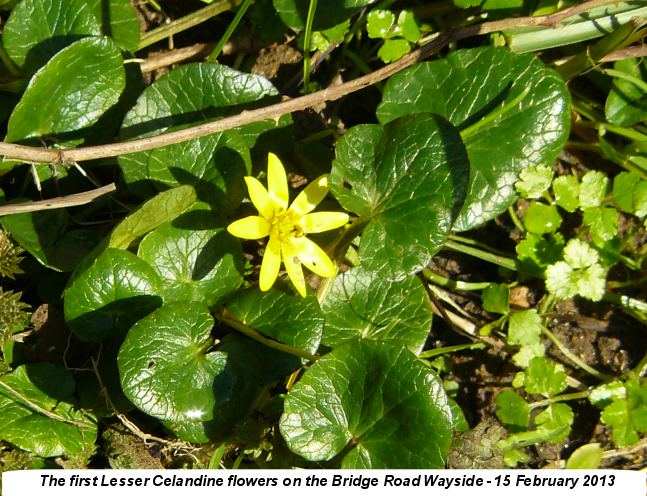
Red
Kite over Westbourne
Keith Marriot left a
phone message for me at 2.30pm this afternoon to say
that a Red Kite had just flown over his house in
Common Road, Westbourne heading for Emsworth.
Unfortunately, I was out all afternoon and did not get
the message until 5pm when the bird would have gone. I
wonder if anyone else saw it?
Red Kites are
regularly seen over the Stansted Forest estate and
occasionally over Hollybank Woods. We had some reports
of Red Kite over Emsworth over the past year:
15-Apr-12 - Richard
Somerscocks saw one flying over Thorney Little Deeps
heading for Emsworth and got this fine photo of it.
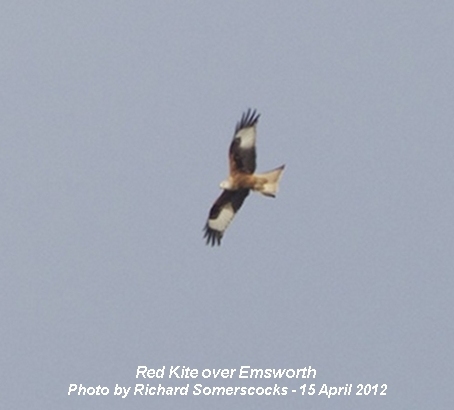
13-Apr-12 - Tony
Wootton had a Red Kite fly over his house in Highland
Close Emsworth heading North.
20-Mar-12 - Patrick
Murphy had a marvellous sight of a Red Kite wheeling
and hovering over his Emsworth garden.
Water
Rail at Baffins
Eric Eddles who lives
at Baffins, finally caught up with the Water Rail on
his local pond today. Nice one, Eric.
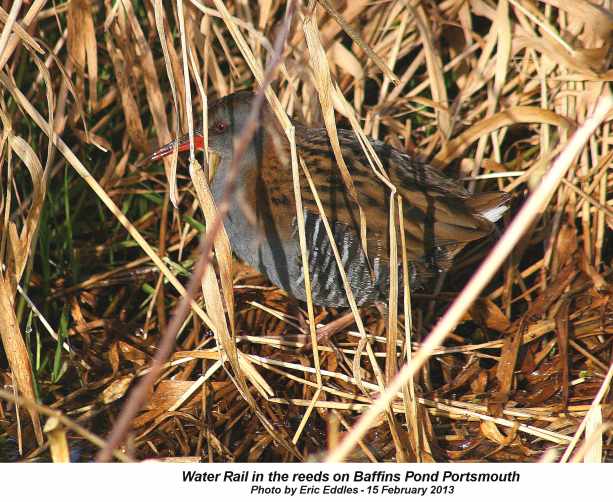
Hayling
Oysterbeds up-date
Chris Cockburn
reports: Several
hundred Black-Headed Gulls were present in the lagoon
at the Hayling Oysterbeds today - most are still in
winter plumage but most are acting territorially
(noisily, of course!). At least three adult
Mediterranean Gulls added to the din; as did the two
regular pairs of Herring Gulls (which will hopefully
move on soon). A few Common Gulls were also present;
they are unlikely to nest - but we can live in
hope.
The
usual Dunlin and Redshank roosts (on the outer bund
and the 'Northwest Bund' on the northern edge of the
lagoon) were displaced today - almost certainly due to
the presence of a roosting sub-adult male Peregrine.
As usual, several Red-breasted Mergansers were
foraging in the lagoon but are now facing difficulties
in feeding with so many gulls in close attendance.
The
lagoon's Silver Eel population decreased by one (yet
again) by courtesy of a Cormorant - this time, the
Cormorant enjoyed its tasty meal unlike a previous
recent occasion when a young Great Black-backed Gull
dropped in and joined a Cormorant in a game of
tug-of-war with an Eel - spectacular to watch and with
the eel as the ultimate winner!
One
Red Admiral butterfly appeared today (from the bramble
bush that thankfully shelters people from the cruel
breezes) and sunned itself in the balmy conditions.
What a difference a calm, dry and sunny day can
make.
I
think that the first phase of the shingle recharge
project on South Binness Island has been completed
(work is only possible during the spring tide cycles)
but it is possible that the machinery will remain on
the island until the next phase can be done. The
over-wintering waders and wildfowl are unlikely to be
affected by the presence of immobile excavator, crane
etc on South Binness and, in direct contrast with the
gulls on the islands in the Oysterbeds' lagoon, the
Mediterranean and black-headed gulls have rarely gone
onto the harbour islands until March and then only for
relatively brief daytime and high tide visits.
THURSDAY
FEBRUARY 14 - 2013
MOUSE-EARS
AT WARBLINGTON
Regarding the Sticky
Mouse-ear that I found in flower on the Warblington
Underpass wayside on Feb 5, Ralph Hollins provided the
following comments in his weekly summary:
"These plants come in
many forms of which two are very common - Sticky and
Common Mouse-ear - and both have similar flowers and
leaves though the flowers of Sticky Mouse-ear grow in
tight clusters while those of Common Mouse-ear grow
separately, each flower having its own flower stem.
When the plants are mature there should be no
difficulty in separating them but I have found in the
past that when I return to a site that seemed to be
composed of Sticky Mouse-ear a few days earlier it now
seems to consist of Common Mouse-ear. This conundrum
seems to have occurred again at a site in Emsworth
where Brian Fellows found and photographed plants of
Sticky Mouse-ear (the photos show the characteristics
of this species) but when I visited the site just two
days later I could only find plants looking like
Common Mouse-ear. It could well be that we saw
different plants in different areas of the site but I
am wondering if it is possible that Common Mouse-ear
starts to flower before the flower stems are fully
grown so a plant which starts to open its flower buds
when they are all tightly grouped and look like Sticky
Mouse-ear rapidly grow individual flower stems making
the plant look like Common Mouse-ear. I hope to
resolve this dilemma before too long!"
Common
Mouse-ear
I think I have
resolved Ralph's dilemma for this morning I found what
I think are both Common Mouse-ear and Sticky Mouse-ear
on the grass verges west of the Warblington Underpass.
The Common Mouse-ear is growing on the embankment
immediately west of the Underpass. I think these are
the plants that Ralph looked at when he visited the
site. As he says, the flowers of Common Mouse-ear are
less clustered than Sticky Mouse-ear and each have
their own stem. The plant is far less hairy than its
Sticky cousin.
Here
is the Common Mouse-ear at the Warblington Underpass
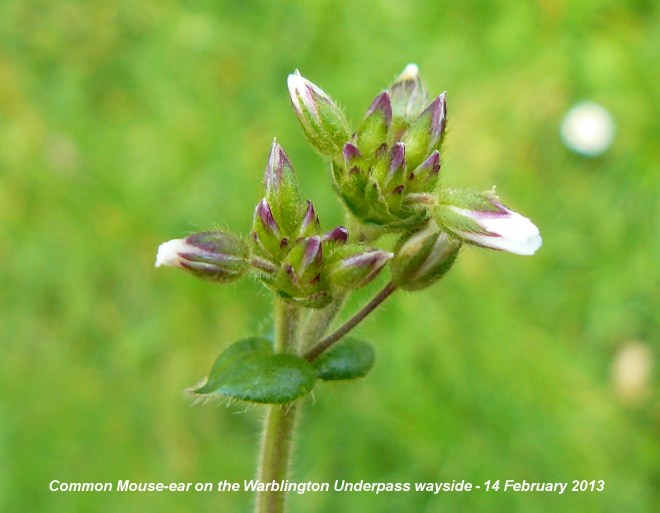
Sticky
Mouse-ear
The Sticky Mouse-ear
is growing on the broad central grass verge and these
are the ones I photographed on Feb 5. These have a
tight cluster of flowers at the top of the stems.
Here
is the Sticky Mouse-ear at the Warblington Underpass
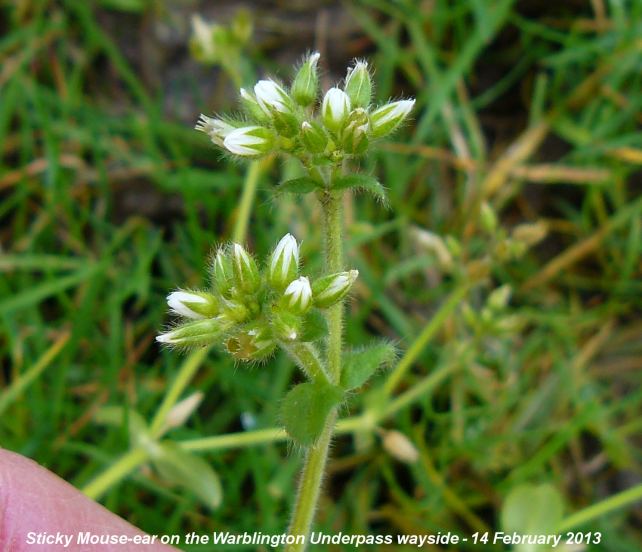
I also had a close
look at specimens of the two plants under the
microscope and the hairs on the Sticky Mouse-ear are
glandular (making the plant 'sticky'), but not those
of the Common Mouse-ear. Rose (New Ed, p.152)
indicates that this as an important distinction
between the two plants.
INSECTS
Bumblebee
Considering the warm
temperature today, I was not surprised to see a
Buff-tail Bumblebee (Bombus terrestris) flying while I
was looking at the Mouse-ears on the Warblington
Underpass wayside.
Red
Admiral
Nor was the Red
Admiral totally unexpected that I found sunning itself
on the tarmac path in front of my house this
afternoon. The insect was very dozy and allowed me to
pick it up and transfer it to the large Ivy hedge in
the back garden where it could get more shelter. The
photo shows the insect on the tarmac path.
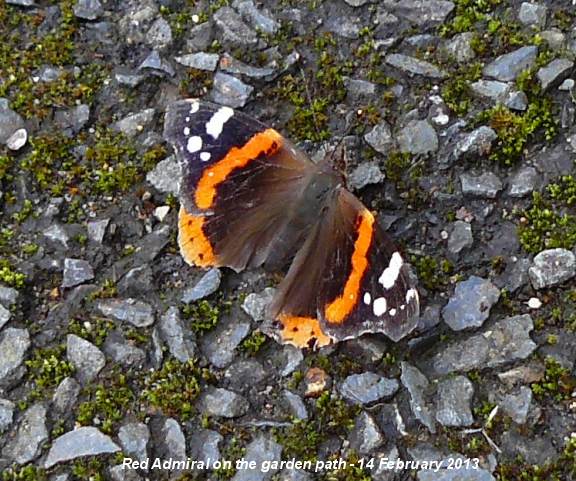
RALPH
HOLLINS NEWS
Victoria
Road Rookery
Ralph Hollins found
ten Rooks back at the Victoria Road rookery this
morning and one nest vas visible, So the Rooks have
not deserted Emsworth, but do seem to be declining in
number.
Brook
Meadow
Arriving on Brook
Meadow from Seagull Lane Ralph saw a female
Blackcap fly out of the gardens across the lane
near the Rail Bridge and into the reserve where a
Great Spotted Woodpecker was drumming as usual
in the north east of the meadow. Ralph checked the
Butterbur on the main river path and was
surprised to find one plant was hiding open flowers
under a leaf and nearby were a couple of Winter
Heliotrope flowers.
A little further south
Ralph saw the Common Alder in flower (reported
yesterday) and back on the causeway heading for Lumley
Road he had a look at the 'Cherry Plum'
blossom. I am never really sure of this plant ,
but Ralph thinks with the total absence of green twigs
it is not the standard Prunus cerasifera. But he could
find no clues (other than the white flowers which are
2cm across) to determine which of the Prunus
cerasifera cultivars it was but thought it might be P.
cerasifera ie, Myrobalan Plum. This is what we have it
down as in the Brook Meadow plant list.
Lumley
Ralph found no
Frogspawn in the Sadler's Walk pond. He went back up
Lumley Road to Westbourne, where he saw a Mistle
Thrush in the field near the river as he came down
from the A27 bridge and wondered if it was possibly
breeding there? We need to keep a look out, for Mistle
Thrush is a very rare bird in the Emsworth area.
A little further up
Mill Lane Ralph turned his bins onto an Egret in a
small pool and found a Fox out in the open,
lying with its back to the Egret (maybe a ploy to
bring the bird within range?). At the top end of Mill
Lane the Alpacas had both Goats and Sheep
sharing their field.
Hampshire
Farm pond
Heading back towards
Southleigh Road Ralph noticed that a new pond was
being dug out in the new housing development area. He
thinks this is one of the three promised by the NRA to
prevent flooding in Emsworth. At the start of his trip
Ralph found work going on in the field west of
Selangor Ave where another of the three is to be
sited.
OTHER
NEWS
Spotted
Redshank
I went over to Nore
Barn at about 12 noon and found the resident Spotted
Redshank feeding among the seaweed on the shore at the
end of Warblington Road. It seems to have taken to
feeding on the shore in preference to the stream. It
was disturbed by a dog and flew over to the stream
where I got this photo. I met John Hilton who was also
taking photos of the Spotted Redshank.
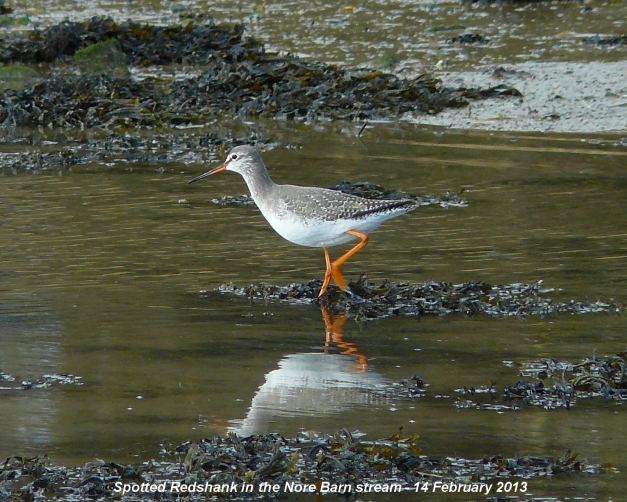
Water
Vole on Brook Meadow
Brian Lawrence
e-mailed to say he saw a Water Vole today swimming
under the north bridge, but did not get a photo as he
was not quick enough. This was the 35th sighting for
the year so far. Quite amazing!
Water
Rail on Baffins Pond
After trying to
photograph the Brook Meadow Water Rail for about two
weeks, Mike Wells decided to take a trip down to
Baffins Pond where he finally got the picture he
wanted! The Water Rail was in one of the new wetlands
area of the pond.
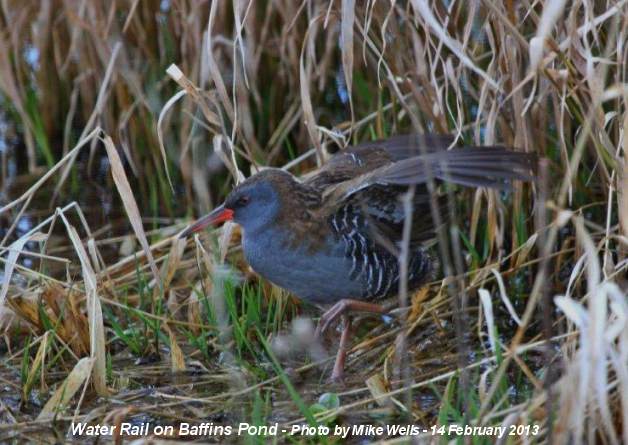
The Water Rail of
Baffins Pond has a long history going back, at least,
to February 2003 when I recall seeing the bird there
for the first time. It was so tame that it came onto
the path where people were walking and actually took
food!
Hayling
Oysterbeds news
Chris Cockburn says
you should get your ear plugs ready for when you next
visit the Hayling Oysterbeds. "Judging by the few
Black-Headed Gulls presently there, they have not
become any quieter and we will have to wait until
July/August for peace to return. One of them is more
or less in complete summer plumage and acting very
territorially. So, the 2013 breeding season at the
Hayling Oysterbeds seems to be entering the
preliminary stages; but, probably, nesting will not
start until the last week in March.
Not just a few
black-headed gulls, but a pair of Herring Gulls are
continuing to act very suspiciously and noisily on the
western island. Chris says, if you do visit the site,
it would be very helpful if you would please report
any signs of rats, foxes or any other potential
predators to him.
WEDNESDAY
FEBRUARY 13 - 2013
BROOK
MEADOW
Sandbags
Maurice Lillie
understands that the sandbags reported in yesterday's
entry, were placed by the Fire Brigade to prevent
further water penetration to the cottages in Lumley
Road. Maurice does not know if water actually breached
the wall as there does not seem to be any flow route
and when he looked there the afternoon before, the
water level was high but at least two courses of
bricks (150mm) below the top of the lower part of the
wall.
Two
male Firecrests
I met Brian Lawrence
in Palmer's Road Copse who told me that he had just
seen two male Firecrests, one chasing the other away
from the bushes south of the observation fence. This
was our first sighting of two males. Brian also saw a
Goldcrest, but not the female Firecrest. After Brian
had gone, I met Robin Pottinger and we both had a good
view of a male Firecrest with a bright orange crest
working its way through the vegetation on the flooded
west bank of the river south of the observation fence.
I also saw the Firecrest chase what could have been
Brian's second male Firecrest across the path into the
wooded area near the car park. However, I did not see
it clearly enough for proper identification.
Here
is my shot of the male Firecrest
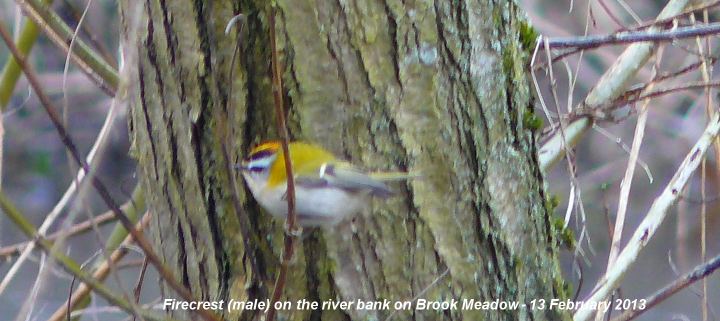
Water
Vole
Robin told me he had
just seen a Water Vole on the open area of the west
bank of the river south of the north bend in the
river. This was the first sighting from this section
of the river for over a month.
Other
observations
A pair of Mallards
was dabbling together in the flooded river in
Palmer's Road Copse, close to the Deep Water sign.
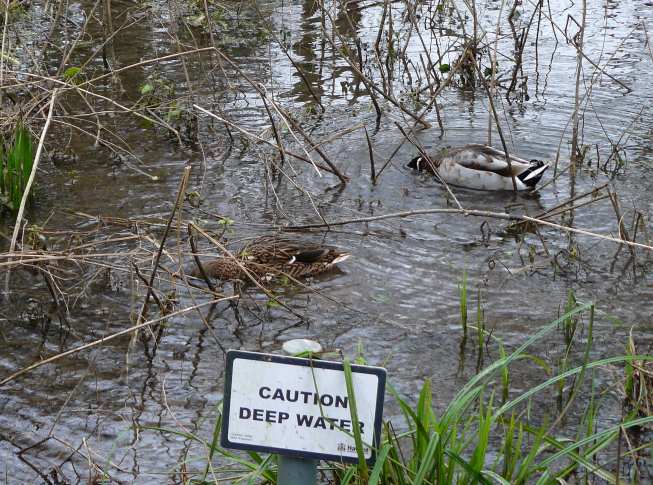
The Alder catkins are now fully open in the
plantation on the west side of Brook Meadow and
showing well in contrast with the brown gnarled cones
from last year.

On Emsworth Millpond the Black-headed Gulls are
starting to get their dark heads of breeding plumage.

TUESDAY
FEBRUARY 12 - 2013
Brook
Meadow
The river level has
gone down since yesterday which means the path through
Palmer's Road Copse is negotiable as is the path
through the south meadow.
I was surprised to
find a line of white sandbags piled along the top of
the retaining wall of the river where it emerges from
the tunnel beneath the railway. They are presumably
designed to prevent the river flooding onto the
meadow, though I do not recall ever having seen the
river go over the retaining wall at this point.

Water
Vole
I spotted movement on
the west bank of the river in Palmer's Road Copse
behind the 'Deep Water' sign and with my binoculars
saw a Water Vole pulling twigs and long strands of
vegetation. The vole came down to the edge of the
water where it preened for a little while before
dipping into the river and disappearing into an
underwater burrow hole. This is probably the same vole
that has been seen several times this year at this
spot. This takes the total number of Water Vole
sightings for 2013 to 33.
Firecrest
A Firecrest was
feeding actively in the vegetation on the flooded west
bank of the river in Palmer's Road Copse, in much the
same place as I saw it on Feb 8. The photo clearly
shows a yellow crest which suggests this was a female.
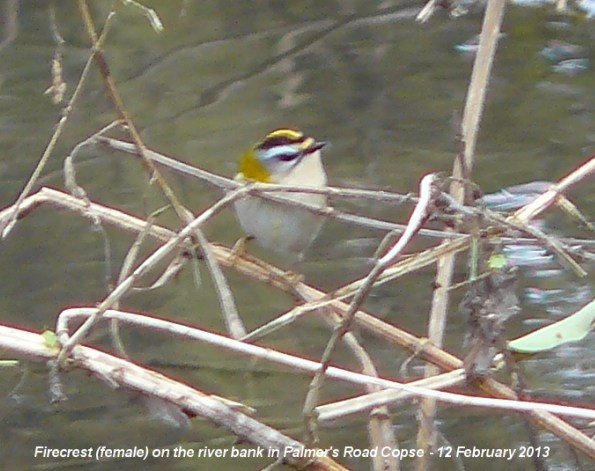
Other
bird news
A pair of Blue
Tits were active in the vicinity of the nest box
on the tall tree above the Water Vole signcase. Blue
Tits regularly nest in this box. I heard a full Blue
Tit song for the first time this winter on Brook
Meadow.
In addition to Blue
Tit, the following birds were singing on Brook Meadow
this morning: Robin, Dunnock, Wren, Great Tit and two
Song Thrushes. A Great Spotted Woodpecker was heard
drumming from the tall dead tree in the north-east
corner of Brook Meadow, as it was on Feb 8. I heard
two tones of drumming, one high pitched and one low,
indicating the use of two different resonating
surfaces by the bird.
The Blackbird with
a large white patch on its wing is still prominent
in the Lumley area. To my knowledge it has been seen
in this area for at least 3 years. I saw it today in
the bushes by the Lumley puddle.
Here
is a photo of the bird taken in March 2011 by Tony
Wootton
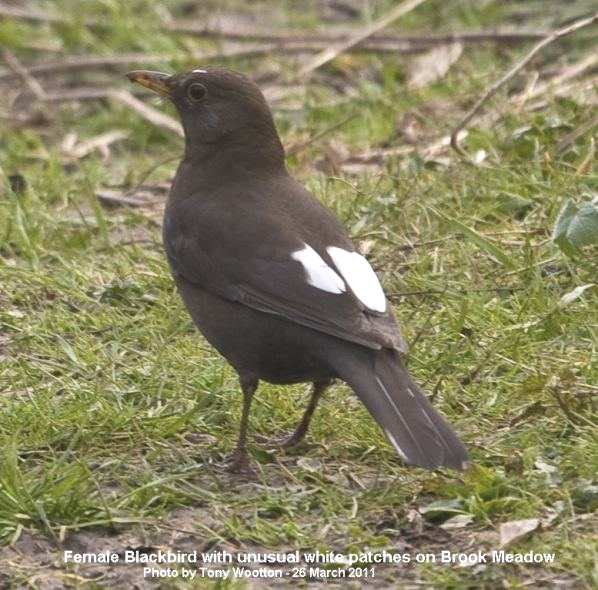
Slipper
Millpond
The five Tufted
Duck that were on the pond yesterday were still
there today in a tight group, 3 males and 2 females.
Also, on the pond was
a pair of Mute
Swans, but not
the resident pair which were over on Peter Pond. I
think this is the pair, which includes the 'Polish'
swan with pinkish legs, that has unsuccessfully
attempted to nest on Slipper Millpond in previous
years.

Greater
Periwinkles
While walking up
Warblington Road to Nore Barn, I noticed that Greater
Periwinkle with the dark blue propeller-like petals
was in flower outside house number 45 much as in
previous years. According to Martin Rand (March 2011)
this is a form of Greater Periwinkle called
Vinca major var. oxyloba. Martin added
that it seems a common garden plant but that he only
had 5 records of it outside gardens in Hampshire and
was under recorded. The standard garden form of
Greater Periwinkle with large petals of various hues
of blue is called Vinca major.
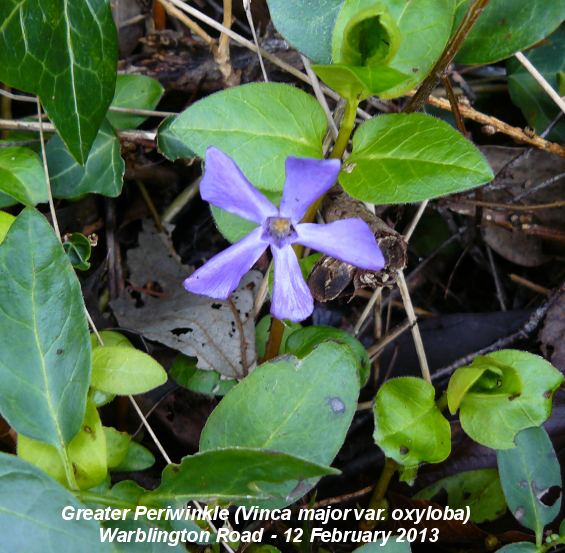
Ralph Hollins has
already seen Lesser Periwinkle (Vinca minor) in flower
in Pitts Copse, Stansted and on the south facing hedge
bank immediately east of the East Leigh/Southleigh
Road junction in the Denvilles area of Havant.
Regarding Intermediate Periwinkle (Vinca difformis)
Martin said this is much rarer as an escape.
OTHER
NEWS
Waxwings
Tom Bickerton got the
Waxwings in Bedhampton, this morning at 7:20am. They
were crossing Purbrook Way by the Hyper-market, going
south up Hulbert Road. Without doubt the same flock as
Peter Milinets-Raby's been recording.
Spotted
Redshank
Ros Norton was on a
Chichester Harbour walk this morning and they saw the
Spotted Redshank feeding very close to bridge over
stream at Nore Barn at 11.25am.
Lichen
Yellow crustose lichen
is abundant on the large rocks along the shoreline of
Western Parade.
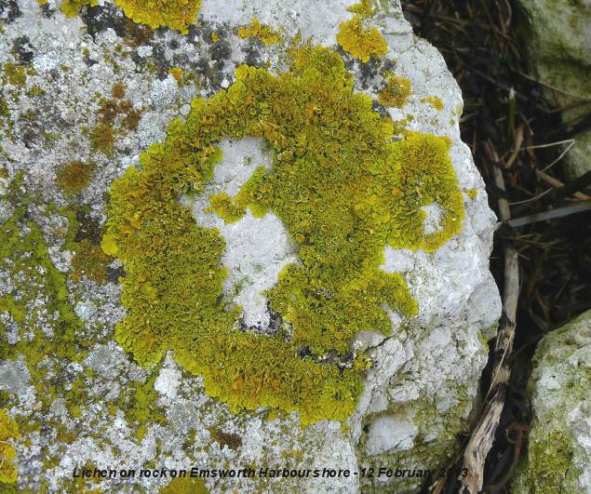
MONDAY
FEBRUARY 11 - 2013
Brook
Meadow flooding
Following the
continuous rain yesterday, the River Ems was running
very high and had flooded the path through Palmer's
Road Copse. The south meadow of Brook Meadow was
similarly flooded and not accessible without boots.
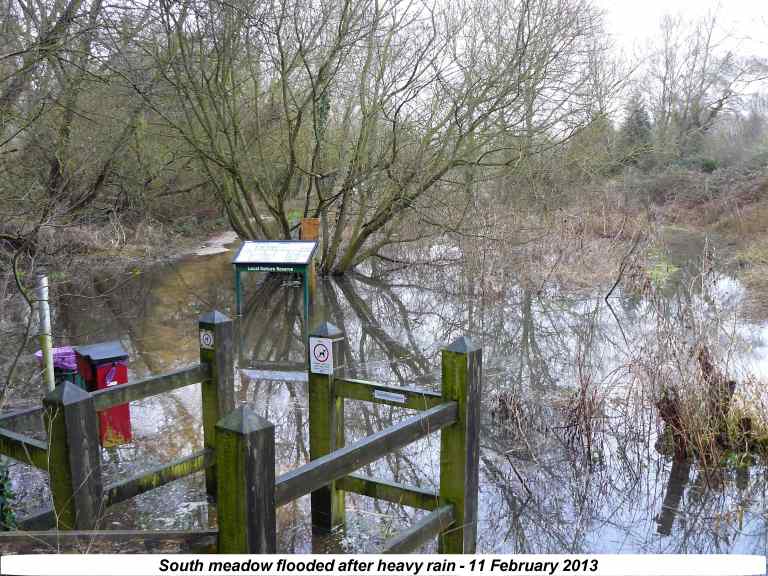
Firecrest
on Brook Meadow
I walked back through
Brook Meadow along the main river path this morning
and spotted the male Firecrest actively foraging on
the river bank in front of the gasholder. I tried
without success to get a photo. It was constantly on
the move. A little later I saw a Goldcrest moving
along the western river bank, roughly where I saw it
on Feb 8.
Lungwort
in flower on Lumley Path
A few plants of
Lungwort (Pulmonaria officinalis) are in flower
on the south side of the Lumley Path which leads from
the Gooseberry Cottage drive through to Lumley Road.
Lungwort has regularly flowered on the Lumley Path on
Brook Meadow over the past 13 years and once
(21-Jun-12) on the Seagull Lane patch. Its flowers are
bell-shaped and reddish-pink often turning blue. The
sepals are covered with glandular hairs and leaves
oval and pale spotted. They can be seen in the photo.
This takes my personal list of flowering plants for
February to 24.

Lungwort
(Pulmonaria officinalis) is a perennial herb,
originally a garden plant, but now naturalised in
woodlands and scrub, on banks and rough ground, and
also occurring on rubbish tips and waste ground. It is
a Central European temperate species, absent as a
native from much of W. Europe.
Tufted
Ducks on Slipper Millpond
Brendan Gibb-Gray had
five Tufted Ducks (three male and two female) on
Slipper Mill Pond outside his house this morning. He
thought may have been blown in by the awful weather of
the past 48 hours. Tufted Duck are not as common on
Slipper Millpond as on the town millpond, though they
have also been scarce there this year. Brendan's birds
most likely came up from Thorney Little Deeps where
they reside. I went to have a look at them this
morning and all five were still present.
Here
is a pair of the ducks with the male taking a close
interest in the female

Juvenile
Sparrowhawk in garden
We had masses of birds
in the garden this lunch time including 25
Chaffinches, 4 Goldfinches, 4 Woodpigeons, 2
Blackbirds, 2 Blue Tits and a Dunnock. Then, in a
flash, they all went, leaving behind a solitary brown
bird perched in the cherry tree. It was a juvenile
Sparrowhawk; it had warm brown upper parts with a few
small patches of white and brown streaked underparts.
It flew to the fence at the end of the garden for a
few seconds and then flew off not to be seen again. It
did not stay in one place long enough for a photo, but
there was no doubt about its identity.Sparrowhawk is
quite a rare bird in our garden, though we do get
between two and five sightings each year. I do not
recall ever having seen a juvenile in the garden
before.
Here
is the only juvenile Sparrowhawk I have in my files -
taken by Dave Lee in his garden in August 2009
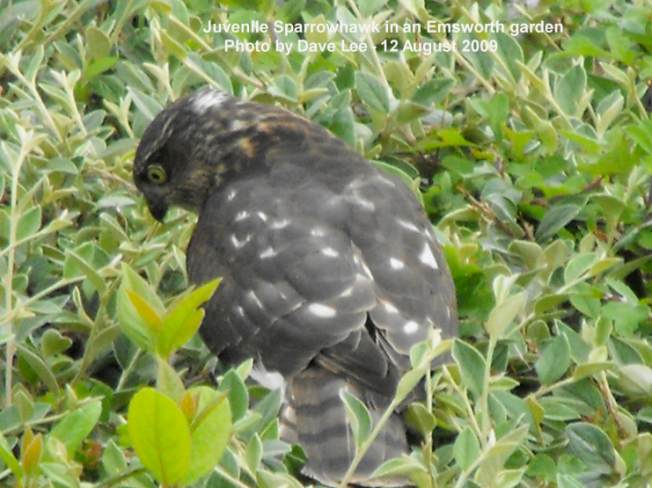
Spotted Redshank
Mike Wells got the
following shot of the Spotted Redshank at Nore Barn
before the snow arrived. One can see from the photo
how the bird's plumage is starting to darken as it
acquires it breeding plumage.
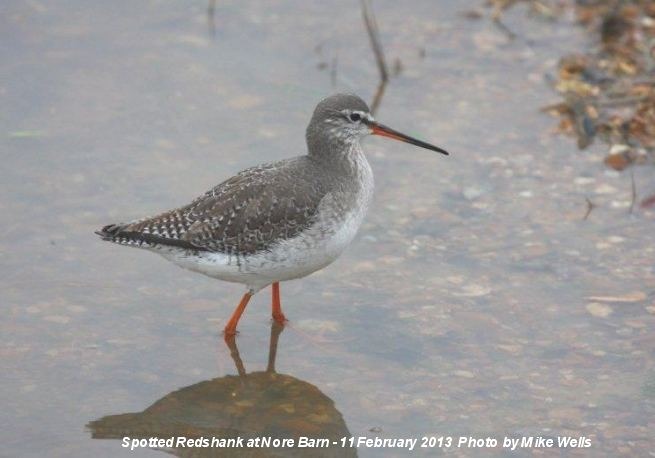
SUNDAY
FEBRUARY 10 - 2013
Black-tailed
Godwits return
Ruth Croger and Pete
Potts did the Hayling WeBS count yesterday on the
falling tide at Northney (east of Hayling bridge) and
saw 99 Black-tailed Godwits, 8 of which were
colour-ringed all from Farlington, so Pete thinks they
are starting to disperse and feed back on the mud
again. Pete has not heard any reports from Pagham for
a while, but when he and Ruth were in the Avon Valley
on Friday at least 2000 were still there and they read
12 colour-ringed combinations (8 from Iceland only 2
ringed in Solent).
Pete added that the
incredibly wet year/winter meant grassland sites
became so attractive to the Godwits that there must
have been c.5-5500 on grassland between Avon Valley,
Solent sites, Pagham & Pulborough. With rain this
weekend will they head back to grassland sites once
more? On Thames they have had up to 9000 roosting at
Cliffe marshes - the good breeding season has swelled
the flocks.
Here in Emsworth
Black-tailed Godwit numbers vary from one year to the
next. In 2011 they tailed off in February and never
came back. In 2012 they only had a short break in
early January and numbers remained good until the end
of February. This year numbers fell in December and
are still low. I had 22 on Jan 23, but Peter
Milinets-Raby only had 6 at Nore Barn yesterday.
However, we shall keep looking.
Great
Spotted Woodpecker
Romney Turner had a
cracking experience on Brook Meadow on Friday when she
saw three Great Spotted Woodpeckers. That is an
experience I have never had. First she heard drumming,
like I did also on Friday. Then she found two
Woodpeckers in trees on the north path by the railway
line and stream. Neither were too bothered about
Romney's presence, far more interested in each other
from their different trees. She next saw them high up
in a big dead tree and got near enough for lots of
photos. One bird was intent on drumming from time to
time, the other was watching but not drumming. That
was when a third Great Spotted Woodpecker arrived much
to Romney's great delight.
Here
is Romney's fine image of a female Great Spotted
Woodpecker, possibly drumming
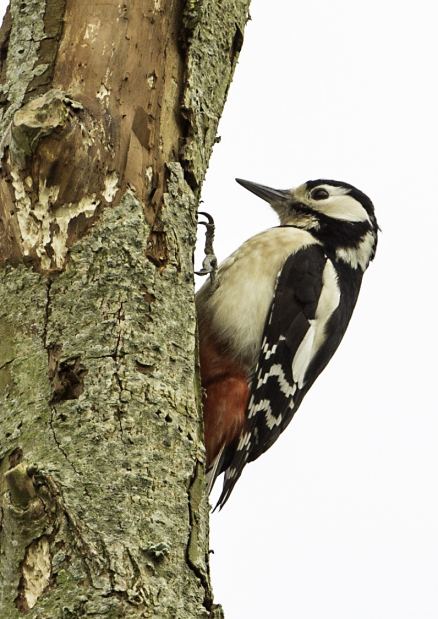
Kingfisher
in garden
I had not seen a
Kingfisher all winter despite a lot of looking out for
one in the usual places, like along the River Ems,
around the millponds and in the harbour. However, we
had a brief 30 second visit from one yesterday on our
back garden fence over looking the Westbrook Stream.
My last sightings of Kingfisher in the garden were in
the winter of 2007-08.
SATURDAY
FEBRUARY 9 - 2013
Peter's
Warblington walk
Peter Milinets-Raby
reports on what is fast becoming his usual walk this
morning, from Nore Barn, along the shore and inland
along Pook Lane and back. He started at 7:45am and
finished two and a half hours later. A bit
damp!
"The highlights were:
2 Spotted Redshank on Nore Barn (the old faithful was
incredibly tame (less than 2 metres), until dog nearly
took it and owner just looked dumbfounded and
apologised profusely for scaring off my photo
opportunity!!!),
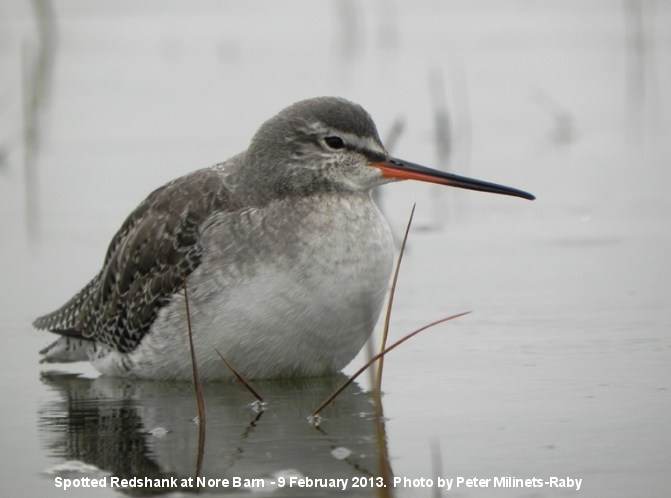
Greenshank on the
field with the pond, 67 Knot at Nore Barn along with
120+ Dunlin, 2 Grey Plover, 6 Black-tailed Godwit, 1
male and 3 female Reed Bunting by the pond and a
singing male further along.
At Conigar Point: 350+
Dunlin, 42 Knot, 19 Grey Plover, 13 Bar-tailed Godwit,
6 Black-tailed Godwit, 14 Pintail, a female Goldeneye,
Great Crested Grebe. 2 Roe Deer along Pook Lane, plus
17 Curlew feeding in one of the fields. 8 Stock Doves
here as well along with 4 Pheasant.

2 Little Egrets in the
fields by the church with 11 Lapwing. No Fieldfares
(seemed to have departed back north!). Buzzard and
Sparrowhawk also seen and Great Spotted
Woodpecker."
Most interesting among
Peter's sightings were the 100+ Knot around the Nore
Barn and Conigar Point area, the most we have had
there this winter.
FRIDAY
FEBRUARY 8 - 2013
BROOK
MEADOW
I had a walk around
the meadow late this morning, hoping for Water Vole
and Firecrest and I was lucky enough to see both.
Water
Vole
At about 12.30pm, I
watched a Water Vole swim towards me through the
flooded west bank of the river in Palmer's Road Copse
close to the 'Deep Water' sign. It settled in a tuft
of Pendulous Sedge and for the next 10 minutes or so
proceeded to feed on the leaves quite oblivious of me
watching and taking photos.
Here is the vole
chewing on one of the sedge leaves

and here it is eating
a leaf with its paws.

This is probably the
same vole that has been seen several times by Malcolm
Phillips in this section of the river - ie Section D.
This is the 32nd sighting of 2013, which is by far the
best start to the year we have ever had for Water Vole
sightings.
Goldcrest
As I was watching the
Water Vole, a Goldcrest came into view and actually
settled for a moment in the tuft of Pendulous Sedge
where the vole was feeding. It was highly active and I
pursued it down the river bank taking photos whenever
I could.
This was my best
effort of this very active bird.
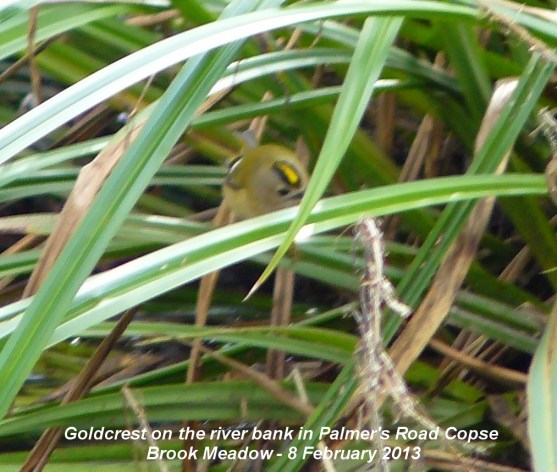
Firecrests
By the time I had got
to the area of the flooded footpath, I suddenly
realised that there was also a Firecrest feeding in
the same area. Inspecting my photos afterwards I
realised it was the female Firecrest with a yellow
crest, which had previously been photographed by
Patrick Murphy on Feb 1.
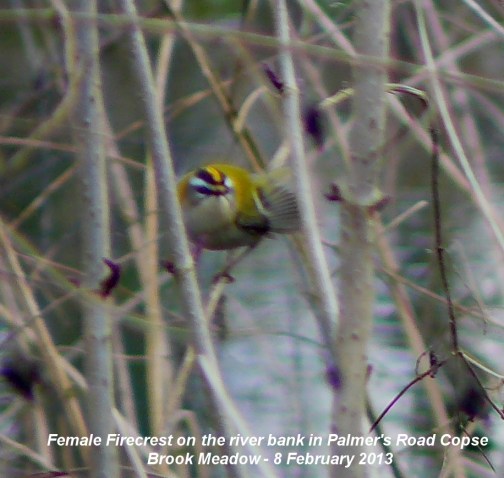
I did not see the male
Firecrest, but Brian Lawrence was on Brook Meadow this
afternoon at about 3pm and did see and photograph the
male Firecrest with distinctive orange crest.

Woodpecker
drumming
I heard a Great
Spotted Woodpecker drumming from the north-east area
of the north meadow. I was surprised to read that both
sexes drum, so this could have been male or female. It
is the equivalent of a song, used to attract a mate
and establish territory. The sound seemed to be coming
from one of the tall Crack Willow trees on far side of
meadow. It was not loud, probably due to the bird's
choice of a poor resonating surface. This is not
particularly early. Ralph Hollins said the first
report of drumming came from Arundel on Jan 7 and he
had heard it in the Wade Court area of Langstone on
Jan 19 and 21.
LICHENS
Metal
gate lichen
I found two more
interesting lichens today. A yellow crustose type
lichen is growing on the metal gate in the front
garden of our house in Bridge Road, Emsworth. This
could be another example of Caloplaca citrina, which
Alan Silverdale's web site says does occur on metal
fences. http://www.lichens.lastdragon.org/Caloplaca_citrina.html
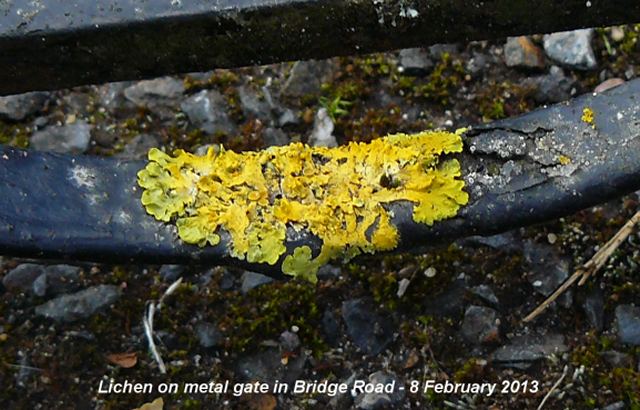
Brick
wall lichen
Another lichen that
caught my eye was on a brick wall on the north side of
Victoria Road. It was similar to the other white
crustose lichens. But it was composed mostly of tiny
white spots and not the usual large patches as in
chewing gum lichen. I have been through the crustose
lichens on the Irish web site without seeing anything
close. http://www.irishlichens.ie/lich-cru-r.html

Ferns
The ferns are still
looking good on the garden wall on the west side of
North Street just south of the entrance to Emsworth
Railway Station. They include Black Spleenwort,
Hart's-tongue and Wall-rue.

WAXWINGS
At 9:20am this morning
Peter Milinets-Raby was in the car heading for his
first driving lesson of the day (Peter is a driving
instructor) when he noticed 2 Waxwings perched in the
bare tree outside 124, Purbrook Way in Havant. Peter
got his pupil to drive past the house 30 minutes later
and the birds were on the TV ariel. About 30 minutes
later at 10:30pm they drove by again and the birds
were in the tree again, but 20 minutes later at
10:50pm they had gone. Peter says, the trees around
have very few berries so the birds are unlikely to
return, but they could be somewhere close.
This follows the
sighting by Frances Jannaway of 4 Waxwings in her
Emsworth garden on Feb 5. Clearly, there are small
numbers of birds in the area and they could pop up
anywhere, so keep your eyes skinned, particularly
where there are berries.
THURSDAY
FEBRUARY 7 - 2013
NORE
BARN
11:30 - 12:30 I spent
an hour or so at Nore Barn on a falling tide with
about three hours after high water.
Spotted
Redshank
The Spotted Redshank
was feeding in the stream when I arrived, but it was
alone.
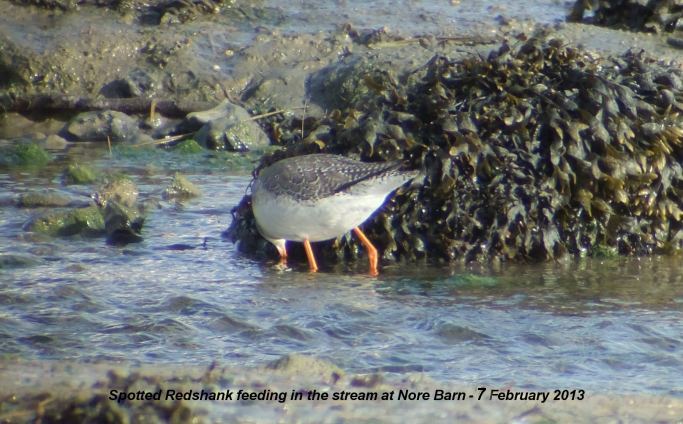
See
all the current Spotted Redshank news and photos on
the special page at .
. . Spotted
Redshanks
There were masses of
Wigeon and Teal in Nore Barn Creek; I would estimate
at least 300 of each, along with a similar number of
Brent Geese. There were also four Pintail and about 25
Shelduck further out in the main channel.
Greenshank
A solitary Greenshank
was feeding and then snoozing at the top of Nore Barn
Creek. This is probably the same bird that often feeds
with the Spotted Redshank in the Nore Barn stream. I
got this nice shot of it snoozing on the mud bank with
a wary eye open for any threats

Carrion Crows were
very noisy in Nore Barn Woods. I watched for a while
and saw the reason, they were harassing a Buzzard,
which seemed very reluctant to leave.
Sun
Spurge
Tony Wootton found Sun
Spurge flowering at Farlington Marshes yesterday. This
plant is not unusual to find in flower in winter.
Ralph Hollins had Sun Spurge on his January flowering
list. It can be distinguished from the similar Petty
Spurge, which also flowers in winter, by its toothed
leaves. Sun Spurge is the only common spurge with
toothed leaves.

The large Ivy hedge at
Nore Barn has no flowers remaining and no insects
either.
Moth
decline
A report by Butterfly
Conservation and Rothamsted Research has revealed that
two-thirds of common and widespread larger species of
moths (macro-moths) declined in the last 40 years. The
losses in abundance were much greater in the southern
half of Britain than the north. Some once-common
garden species such as the V-moth, Garden Tiger and
The Spinach have decreased by more than 90% from
1968-2007 and now face the real threat of extinction
in the future. Ongoing habitat loss and the
deteriorating condition of the countryside are
believed to be the major factors behind these
declines. The declines could have a knock-on effect
for plant pollination and animals reliant on moths for
food, such as garden and woodland birds, bats and
small mammals. However, a substantial minority
(one-third of the 337 species studied) increased, very
dramatically in some cases, such as Least Carpet
Idaea rusticata which has shown a 74,684%
increase.
The full report is at
. . . http://butterfly-conservation.org/files/state-of-britains-larger-moths-2013-report.pdf
WEDNESDAY
FEBRUARY 6 - 2013
Pied
Wagtails
I was out for most of
today, but managed a late afternoon walk around
Emsworth Millpond. The Pied Wagtails were flitting
around as usual at this time of the day. I would
estimate about 50 of them, but they hardly ever stay
still for a photo. Here is just a few of them. I
wonder where they roost at night?
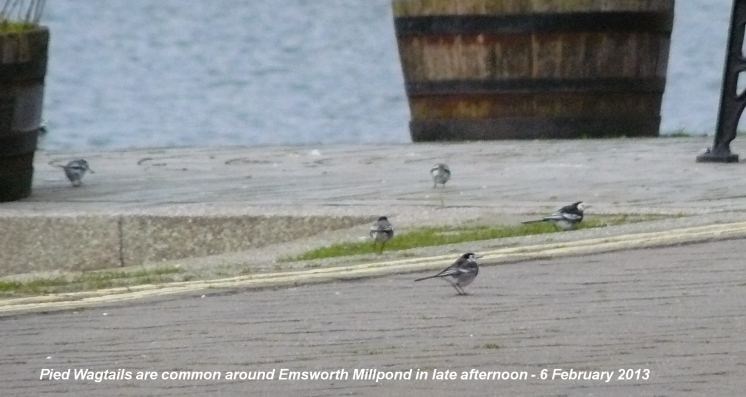
Lichens
Ralph Hollins tells me
he has a lot of the chewing gum lichens Lecanora
muralis on the concrete blocks of his driveway
in Havant. He thinks the blocks have not been there
for more than ten years but almost every block has two
or three of these lichens. The lichen are far more
abundant on my patio where they seem to prefer the
concrete slabs to the red bricks.
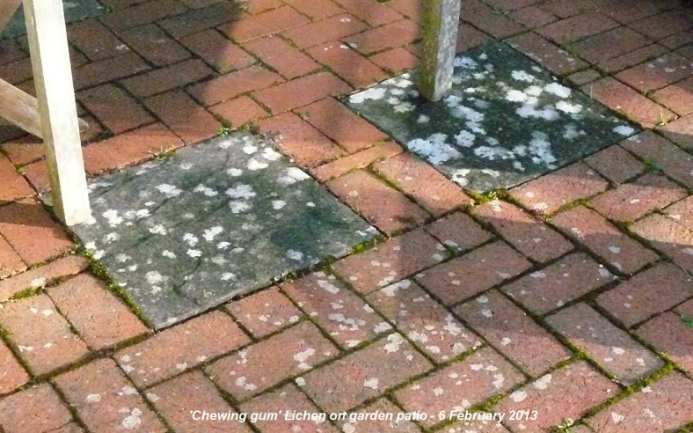
During my walk around
the millpond, I noticed lots of yellow crustose
lichens growing on the edges. Maybe, it is the same
species that I saw on the gravestones in Warblington
Churchyard? Caloplaca flavescens? See
photos on web site . . . http://www.lichens.lastdragon.org/Caloplaca_flavescens.html

For
more information on Lichens go to the special web page
at . . .
Lichens
Great
Northern Diver
Peter Milinets-Raby
was at the entrance to Langstone Harbour yesterday and
saw 2 Great Northern Divers together. He says it was a
bit distant for any decent photos, but he particularly
liked this one for the representation of the 'cold of
the day'

Chaffinch
disease
Recent postings on
Hoslist indicate there is an epidemic of
papillomavirus affecting Chaffinches in gardens. The
main symptoms are swollen legs with scales sticking
out from the legs. The BTO ringers have seen a really
bad case as shown in the following link . . .
http://btoringing.blogspot.co.uk/2009/03/papilloma-in-chaffinches-not-for-faint.html
Clearly, by attracting
Chaffinches into our gardens with food and usually in
a very small area around a feeder, plus having to
share perches on feeders, we are increasing the
chances of the disease spreading. Normally, birds
would be more dispersed in natural feeding habitats,
so it would not be so contagious. As it is a virus,
cleaning is unlikely to kill it and it will be on
surfaces and in the soil around the feeders. The
following web site has more information about this
disease . . . http://www.ufaw.org.uk/infectious-diseases.php#id11
Nesting
Little Terns - Update
Following on from
yesterday's report from Chris Cockburn that some of
the existing shingle mounds on Baker's Island will be
capped with more shingle for the benefit of nesting
little terns, Chris says, "I have just been informed
that the contractor will not be recharging Baker's
Island this year but, instead, will now be recharging
South Binness Island (both sites are down for
recharges as part of the Langstone Little Tern
Project)."
TUESDAY
FEBRUARY 5 - 2013
Sticky
Mouse-ear
I went over to the
Warblington Underpass wayside to check on a plant that
my friend Jack told me had been flowering throughout
the winter on the grass embankments leading to the
Underpass. Jack actually arrived on his bike while I
was there and was able to show me the plant on the
embankment. It was Sticky Mouse-ear with its compact
flower clusters which actually rarely open. It is
distinguished from Common Mouse-ear which has only one
or two flowers at the top of the stem. I found a few
other plants on the centre verge.

Other flowering plants
on the wayside area were Daisy, Common Field
Speedwell, Red Dead-nettle, Annual Meadow-grass,
Dandelion, Petty Spurge, Common Chickweed,
Warblington
Daffodils, Crocuses
and Snowdrops were flowering in Warblington
Churchyard. The pollen sacs were ripe in the
churchyard, but no pollen was given off when I knocked
them.

Lots of lichen were
growing on the old headstones in the churchyard, all
of the crustose type and varying in colour from white,
through yellow to black.
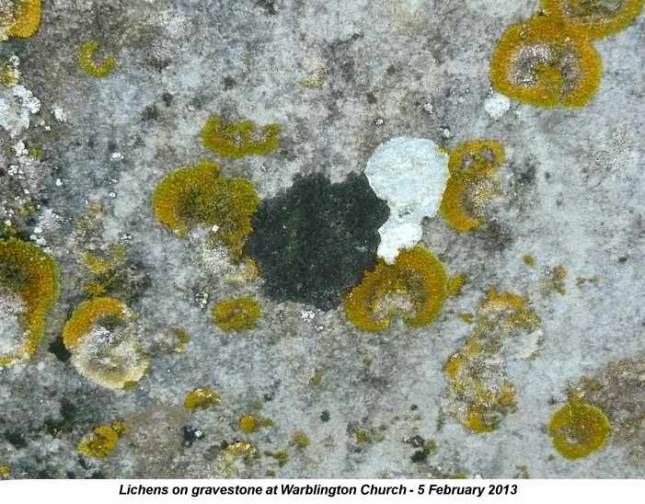
I did the Pook Lane
circuit and found a good show of blossom on the Cherry
Plum tree on the track down to the shore.
I counted 50 Shelduck
on the Warblington shore and a couple of hundred Brent
Geese, which flew over my head as I was walking
through the large field to the cemetery. They were
heading for their favourite field to the west.
Water
Rail
This morning Maurice
Lillie saw the Water Rail on the flooded west bank
about 15 metres south of the 'S' bend,
running/walking/wading through undergrowth and water.
Maurice also briefly saw Firecrest in same location as
Water Rail, but no sign of Water Voles for the second
day running.
Waxwings
Frances Jannaway
e-mailed to say she had 4 Waxwings in her back garden
yesterday afternoon. They were in the top of the False
Acacia tree for quite a while, but made trips onto the
garden to collect rose hips, which they took back to
the tree to eat. These were the first Waxwings
reported in Emsworth this winter, as far as I am
aware.
Herring
Gull pair on Slipper Millpond
Tom Bickerton sent me
the following image of a pair of Herring Gulls, (male
left, female right) in the south raft on Slipper
Millpond. He says, "Looking at them it seems they're
prospecting for a home on the pond, whether the Great
Black-backed Gulls will let them is another issue. If
they do then we can rip-up the text books on bird
behaviour, but nothing would surprise me with the
Great Black-backed Gull pair."
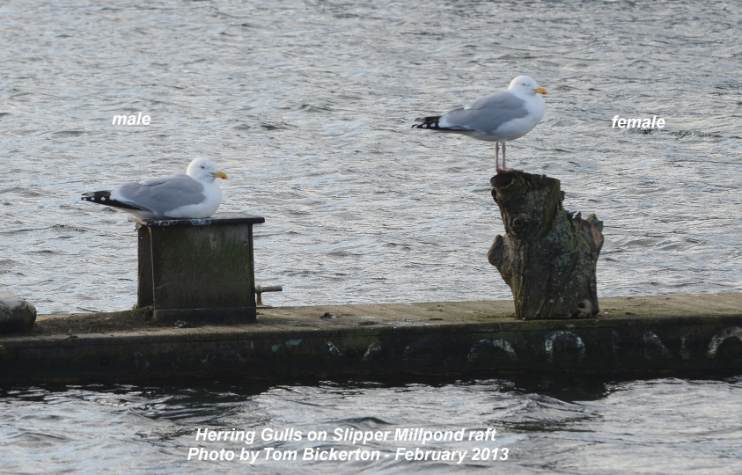
Nesting
Little Terns
Chris Cockburn reports
"As part of RSPB's seabird projects, it is planned to
cap, with imported shingle, some of the existing
shingle mounds on Baker's Island for the benefit of
nesting little terns. If the capping is carried out,
it is hoped that little terns will try nesting at
elevations above typical flooding tides". Let's hope
this improves their breeding which has been virtually
nil over the past couple of years.
Butcher's-broom
flowering season
Regarding the
Butcher's-broom I found in flower in Nore Barn Woods
yesterday (Feb 4), Ralph Hollins informed me that the
flowering season of Butcher's-broom actually starts
towards the end of the summer Aug/Sep and continues
through the winter to the end of April. Ralph has no
records for the months of May to July and has only
once found flowers in August.
His records for the
last two years show:
2011 - 11 records from Jan 4 to Apr 25. 15 records
from Aug 5 to Dec 26
2012 - 7 records from Jan 1 to Apr 30. 8 records from
Sep 12 to Dec 18
2013 - 4 records from Jan 5 to Feb 4.
WILD
THINGS
I watched a the re-run
of programme 3 shown on Monday evening on Channel 4
version of Iplayer which you can see at . . .
http://www.channel4.com/programmes/wild-things/4od
It mainly focussed on
special plants to be found in London due to its warm
atmosphere. The main topics with in the programme were
as follows.
Chewing
gum lichen - Lecanora muralis
This was on pavements
in London and resembles discarded chewing gum. They
cut through a flagstone to show how the lichen
anchored itself firmly to the pavement. The tough
upper surface of the lichen is made up of thousands of
tightly packed filaments which collect the nutrients
and moisture in the air. People walking over it helps
the lichen to spread. This lichen was first seen in
London in 1960 and now it is found on pavements all
over Britain. We have quite a lot on the paving on our
patio at the back of the house.
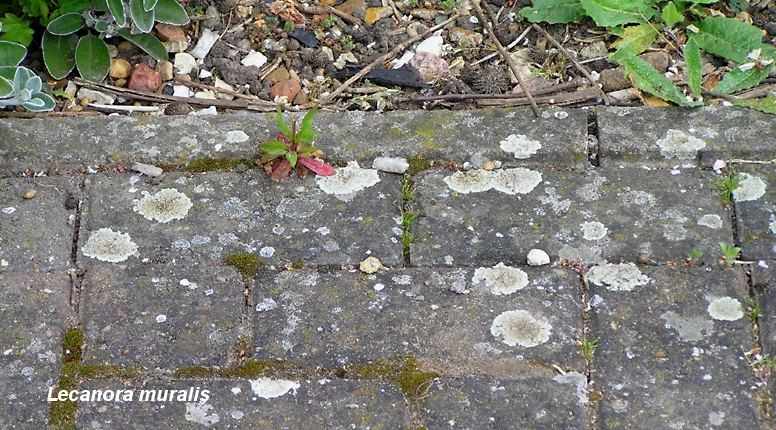
Loquat
- Eriobotrya japonica
This is a large
evergreen shrub or small tree, grown commercially for
its yellow fruit, and also cultivated as an ornamental
plant. Native to China but according to Wild Things it
now grows in the wild in London. The fruit is like a
large plum and the discarded stones (seeds) can
germinate and lead to new plants. According to my
Collins Tree Guide this is unlikely. In the last 15
years Loquat has become established in London due to
the extra warmth in London. The Loquat fruits do not
ripen in Britain.
Passion
Flower - Passiflora
The botanist presenter
was very excited to find this exotic plant growing
wild in London. He said it was native of the Amazonian
rain forest and was imported as a garden plant but
escaped. The first plants in the wild were spotted in
1995 and by 2005 had reached London where it spread
fast where the warmth promoted it growth. It grows
over other bushes and trees using its tendrils to wind
around and choke other plants. The presenter was seen
eating a fruit, but I gather they do not ripen
properly in this country and are not recommended for
consumption! But, the flowers are a good source of
nectar.
From Wikipedia I
learned that Passiflora is a genus of about 500
species of flowering plants and has many hybrids.
From the Wild flower
finder web site I also learned that the one variety
which does grow wild is the Blue passion flower -
Passiflora caerulea. This is rather tender and
sensitive to heavy frosts, and is therefore only
likely to be found growing wild in a major city in the
UK which has a considerable 'heat-island' effect such
that temperatures at night do not fall quite so low as
in the rural areas. Many species of Passion flower
exude a nutrient-rich nectar which attracts ants that
will then attack and kill other insect pests of the
plant that happen to be feeding on the flowers. It
thus encourages ants for its own defence. I think this
is the Passion flower we have in our garden.
Incidentally, this web
site has a sequence of photos of Passion Flowers at
various stages of growth and looks like a good
reference source for wild flowers. http://wildflowerfinder.org.uk/
MONDAY
FEBRUARY 4 - 2013
Brook
Meadow
I met Malcolm
Phillips, Mike Wells and Tony Wootton in Palmer's Road
Copse on Brook Meadow at about 10.30am, all armed with
their long lensed cameras. Tony looks as if he has
just missed out on something good in this snap, though
he did get some excellent shots of the Water Vole and
Firecrest - see below.
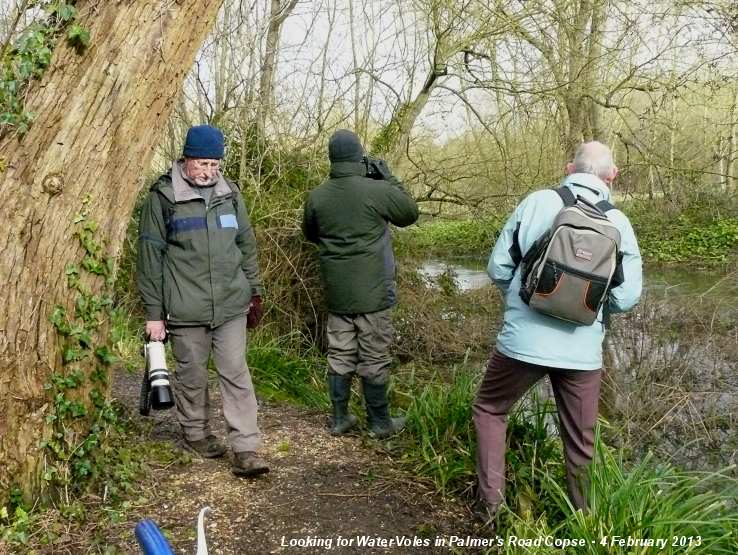
Water
Voles
They had seen three
Water Voles; the first one was on the reeds near the
fence and then swam north. Just as it went out of
sight the second Water Vole was seen by the sluice
gate. The third Water Vole was on the east bank
opposite the Deep Water sign. While I was there we saw
a fourth Water Vole in the bushes on the edge of the
river on the eastern bank.
Here
is Tony Wootton's image of one of the Water Voles
having a good feed

These sightings take
the year's total to 31, which is far ahead of anything
we have experienced before on Brook Meadow. Why are
the voles so active so early this year? It is usually
well into March before we get this this number of
sightings. See the special Water Vole web pages for
all the details . . . http://www.brook-meadow.hampshire.org.uk/bm-water-voles.html
Birds
The
three photographers got a good view of the male
Firecrest. Here is Tony's photo.

Tony
also got this Treecreeper. - Note the tail firm
against the tree for balance
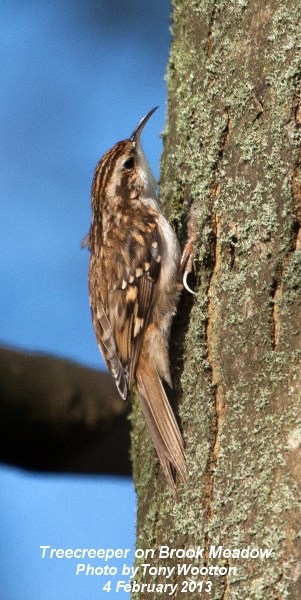
Meanwhile,
Malcolm got this fine shot of a Long-tailed Tit
elsewhere on Brook Meadow.

Lichens
I went on a lichen
hunt and found examples of the three main forms. 1.
crustose - lichens that form patches of
negligible thickness that cannot be scaraped off; 2.
foliose - lichens composed of more visible
"flakes"; and 3. fruticose - little
hairy/fibrous "bushy" lichens that mostly frequent
trees. Classifying the lichens is about as far as I
can go at present!
At the far eastern end
of the north path on Brook Meadow I found a yellow and
grey lichen of the foliose type growing on the twigs
of the Blackthorn bushes. Possibly the same species in
different stages of development? Xanthoria
parietina?

Walking round Emsworth
Millpond I found lots of light green lichen of the
crustose type growing on the inside of the seawall. It
was hard to scrape off a sample. Awaiting
identification.
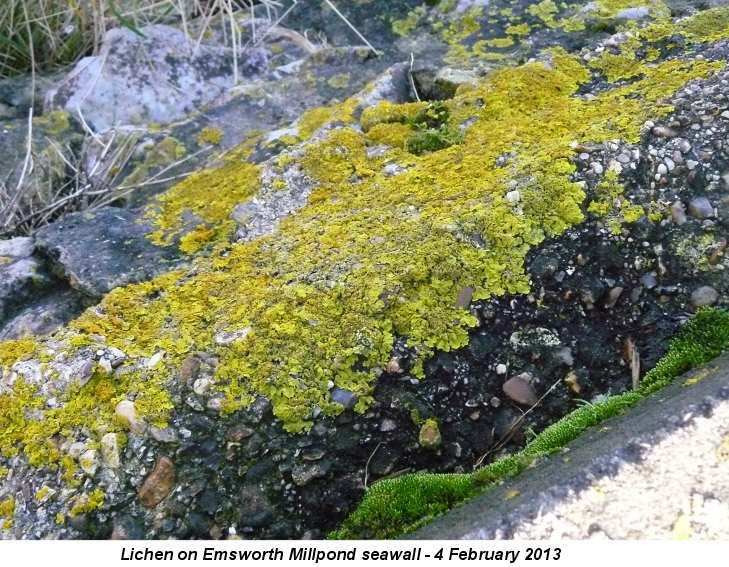
I found more of the
grey 'bushy' lichen of the fruticose type on an Oak
tree on the path west of Nore Barn Woods.
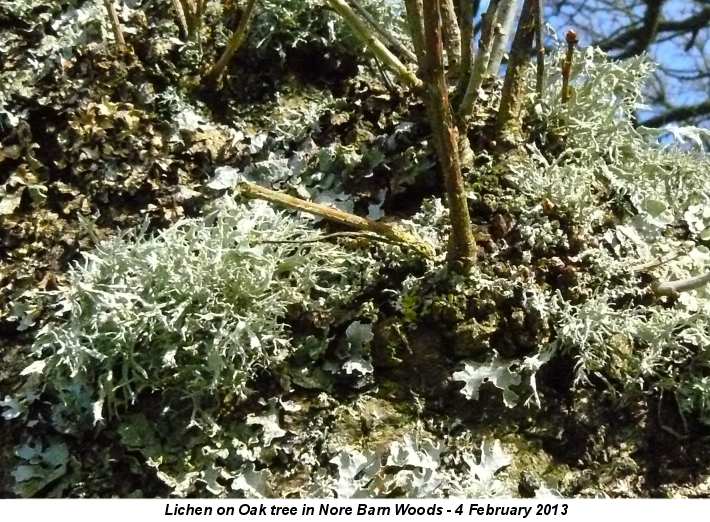
Plants
On Brook Meadow, the
orange 'berries' (botanically, called arils) are
showing well on the Japanese Spindle on the
west bank of the river just south of the north bridge.
Tony Wootton pointed
out some highly nibbled Ivy leaves along the
top of the observation fence and wondered what had
caused it. Clearly, it must have been some sort of
caterpillar feeding there last year.
While in Nore Barn
Woods I discovered a few open flowers on the
Butcher's-broom bush on the southern path. This
plant usually starts flowering in February, though
Ralph Hollins found some flowers out in January.
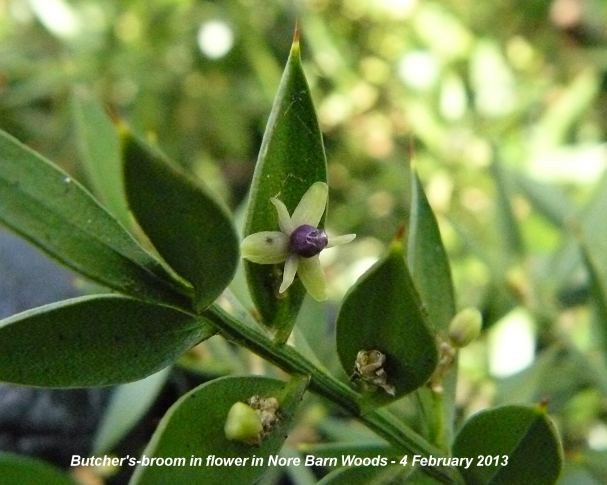
OTHER
NEWS
Egret
in garden
We had a visit from
the local Little Egret onto the garden fence this
afternoon. It stayed for about 10 minutes, looking
down into the Westbrook Stream that flows at the
bottom of the garden, but did not go down as it often
does. Little Egret is a fairly regular visitor to the
garden in winter. Photo taken through the window.

Godwit News
Yesterday, Kevin Sayer
reported a flock of around 1300 Black-tailed Godwits
on Coward's Marsh, near Christchurch at GR SZ152948.
They have also been seen recently at Avon Causeway -
best at dawn & dusk.
Greenshank
at Nore Barn
Brian Lawrence
captured this rather nice image of the Greenshank in
the Nore Barn stream on Saturday Feb 2. Why do they
always look so quizzical? Could they be listening for
food?
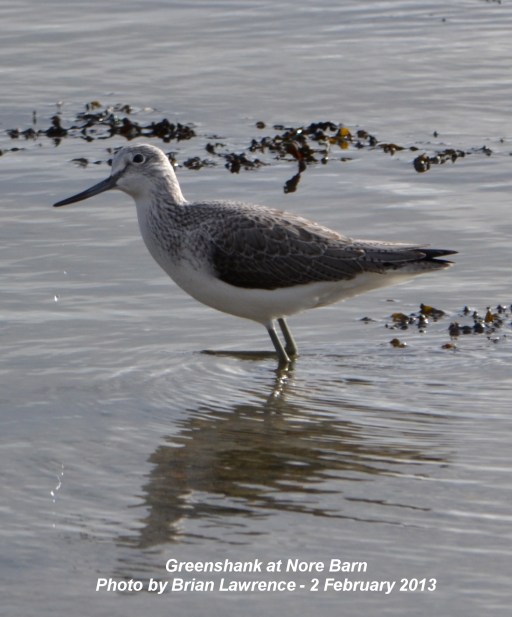
SUNDAY
FEBRUARY 3 - 2013
BROOK
MEADOW
Work
session
I went over to the
meadow this morning mainly to take photos of the
conservation work session. The main job for the work
session was laying the remainder of the path gravel on
the areas that needed reinforcement.
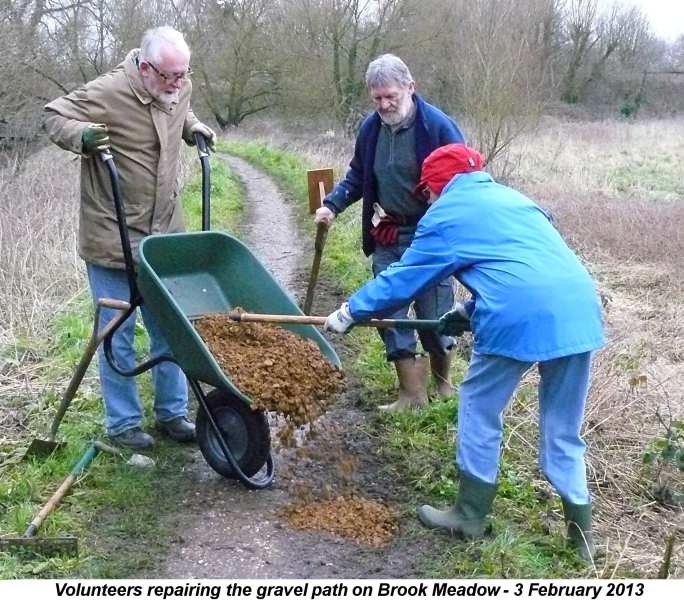
For
the full report on the work session and more photos go
to . . . http://www.brook-meadow.hampshire.org.uk/bm-diary-2013.htm
Wildlife
I had a good view of
the male Firecrest (with orange crest) on two
occasions; first at about 10.15, on the west bank
about 20 yards south of the S-bend and about 10
minutes later in the open area north of the
observation fence. It had clearly worked its way down
there.
On the second occasion
I also spotted the Water Rail slinking around
in the vegetation north of the observation fence, but
it had gone before I got my camera ready. We had some
visitors to Brook Meadow hoping to see the Firecrest
and the Water Rail, but I do not think they did.
Water
Vole
Maurice Lillie saw the
smaller Water Vole again this morning at 08.50 in the
same location as before, about 20 metres south of the
S-bend. This time Maurice had his camera at the ready.
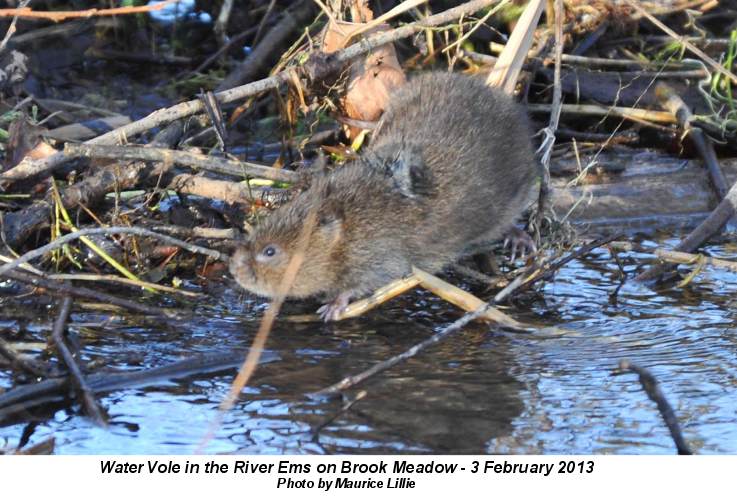
It is interesting to
note the damage to the fur on the Water Vole's back. I
have seen this in the past. Malcolm Phillips photo of
what was probably the same Water Vole on Feb 2 also
shows this damage.
I recall consulting
Water Vole expert Graham Roberts, who said it was
probably the result of females fighting over
territory. This suggests that Maurice's vole is a
female. See my photo of a Water Vole with similar
damage to the of Maurice's taken on 1st April 2003 on
the main Water Vole web page at . . . http://www.brook-meadow.hampshire.org.uk/bm-water-voles.html
OTHER
NEWS
Godwit
News
Kevin Sayer reported:
This morning on Radio 4 there was a broadcast about
Black-tailed Godwits in the Hampshire Avon Valley. You
can listen to this program here http://www.bbc.co.uk/programmes/b01qdpd0
Kevin estimates there
are still around 3500 birds in the valley. 'A big pack
of Black-tailed Godwits' was reported to be present at
Amberley Wild Brooks yesterday, so they are clearly
still in the flooded valleys.
Early
morning at Warblington
Peter Milinets-Raby
was in the Warblington Church area this morning at
5:45am checking the fields around Pook Lane for night
time feeding duck. He heard a few Teal and Wigeon, but
no numbers. He thought we might like to see a sunrise
over the Warblington shore.
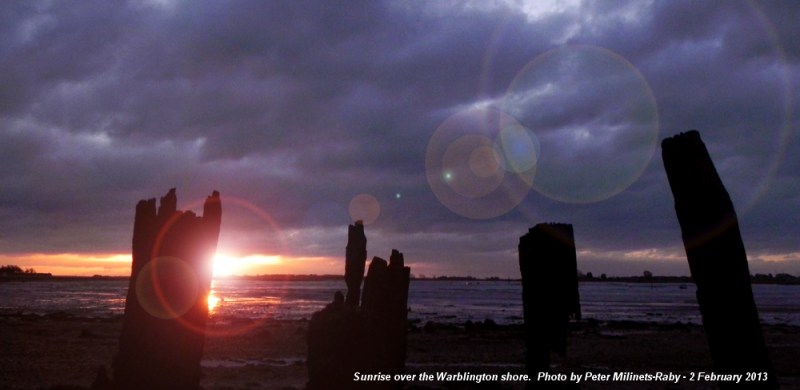
SATURDAY
FEBRUARY 2 - 2013
EMSWORTH
HARBOUR
Red-breasted
Goose
I went down to Nore
Barn at around 12 noon to catch the Spotted Redshank
on the rising tide. While I was there, I met a
visiting birder who was looking for a Red-breasted
Goose that had been reported on Birdguides in Emsworth
Harbour at 10am. We both looked through the 100 or so
Brent Geese scattered around the western harbour, but
there was no sign of the Red-breasted Goose. I suspect
this was the bird that has been on Farlington Marshes
with Brent Geese for the past couple of months and
which had more recently been seen on Thorney Deeps
since Jan 14.
Here
is a photo of the Red-breasted Goose in Portsmouth in
December 2012 by Peter Milinets-Raby

I checked the
Birdguides web site for Red-breasted Goose, which had
the 10:00 sighting in Emsworth Harbour, but also had
another sighting just 5 minutes later at 10:05 at
Thorney Deeps, west of the army guardhouse. So, the
bird's visit to Emsworth could have been a fairly
brief one. Nevertheless, Red-breasted Goose is a first
for Emsworth Harbour!
While I was on the
Birdguides web site I checked Spotted Redshank
sightings and found a nice photo of the colour-ringed
bird W+GY by Jake Gearty at Nutbourne on Jan 24.
Spotted
Redshank
I was rather surprised
that the visiting birder did not seem at all
interested in our local Spotted Redshank which was
showing very well right in front of us on the shore at
the end of Warblington Road. Maybe, it was already on
his list! Local wildlife artist Marion Foster arrived
a little later and while we were watching the Spotted
Redshank a Greenshank turned up. I took some
digiscoped photos including this one showing them
feeding close together.

Marion was fascinated
to hear the story of the Spotted Redshank's nine
winters at Nore Barn and said she would like to do a
painting of the bird. I look forward to that. Marion,
of course, was the artist who created the wonderful
illustration for the Brook Meadow interpretation
board, the original of which is now on show in
Emsworth Museum. Marion also thought the bird needed a
name, so I asked her to come up with one.
All
the news is on the special Spotted Redshank web pages
at . . .
Spotted
Redshanks
BROOK
MEADOW
Water
Voles
Maurice Lillie had
another sighting of what were probably the same two
Water Voles that he has seen in the same place twice
before - 25-30metres south of the 'S' bend. The time
was 08.55 to 09.25. The smaller of the two was
washing, scratching and feeding. Malcolm Phillips also
saw what was probably Maurice's Water Vole and got the
following nice image of it on the river bank.
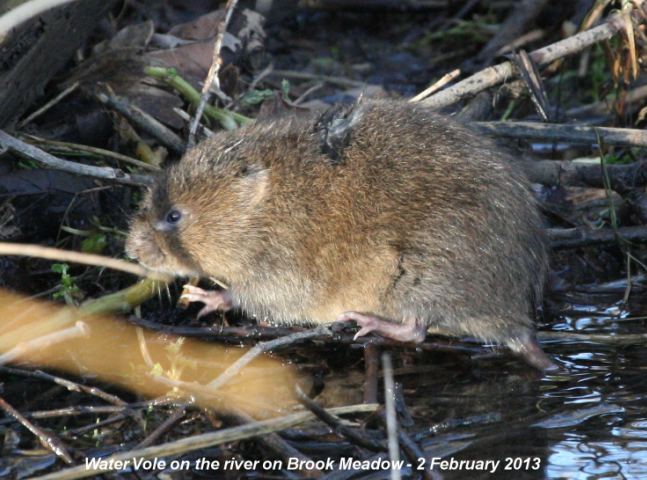
Water
Rail
The elusive Water Rail
was also seen by both Maurice Lillie and Malcolm
Phillips in the same area as the Water Vole, south of
the S-bend, but neither could get a decent photo.
Maurice added, "It
strolled through undergrowth stopping periodically to
peck at things, quite close to the river and travelled
north to the remains of the fallen willows at the
point where the river bends. It stayed by the willows
for several minutes then disappeared from view."
Great
Tit in nest hole
Malcolm Phillips
walked round Brook Meadow this morning and along the
north path saw a Great Spotted Woodpecker leave the
hole in one of the large Crack Willow trees where last
year a Nuthatch was seen working on. Malcolm then saw
a Great Tit go into the same popular hole. Back at the
observation fence Malcolm found the friendly male
Firecrest hopping around in the bushes.
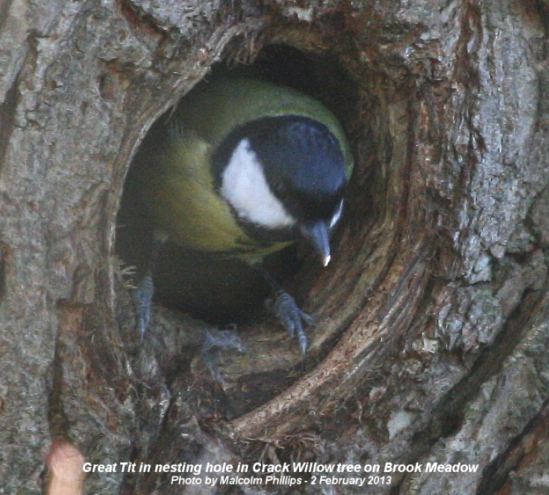
FINDHORN
NEWS
Richard Somerscocks
sends his latest missive from his new home in the
frozen north of Scotland. It is full of interest
complimented by Richard's superb photos which include
Bar-tailed Godwits in flight, masses of Pintail, a
Red-breasted Merganser taking a large Flounder, as
well as two close-up shots of the heads of Cormorant
and Shag to show the difference between them.
Go to the special
Findhorn News page at . . . Findhorn
News
OTHER
NEWS
Waxwings
in Fishbourne
Chris Janman reported
on the SOS Sightings that Waxwings were up to 33 this
morning (just 15 yesterday) in Caspian Close,
Fishbourne, "quite a flighty bunch and a lot of coming
and going, could be more in the area".
Operation
Godwit programme
Pete Potts tells me
that the Operation Godwit project in Iceland will
feature on BBC Radio 4 'Living World' this Sunday Feb
3 at 06.45am. If this is a bit early for you look at
it on Iplayer for a week! . . . http://www.bbc.co.uk/programmes/b01qdpd0
FRIDAY
FEBRUARY 1 - 2013
BROOK
MEADOW
Two
Firecrests
We have the best
evidence so far of the presence of two Firecrests on
Brook Meadow, with photos showing both female and male
birds. The female with yellow crest was captured by
Patrick Murphy near the Water Vole information board,
though he was sure he also saw the male with deeper
coloured orange crest whilst he was watching. In fact,
looking through all the other Firecrest photos they
all show the orange crest of a male bird; Patrick's is
the first to clearly show the yellow crest of a
female.
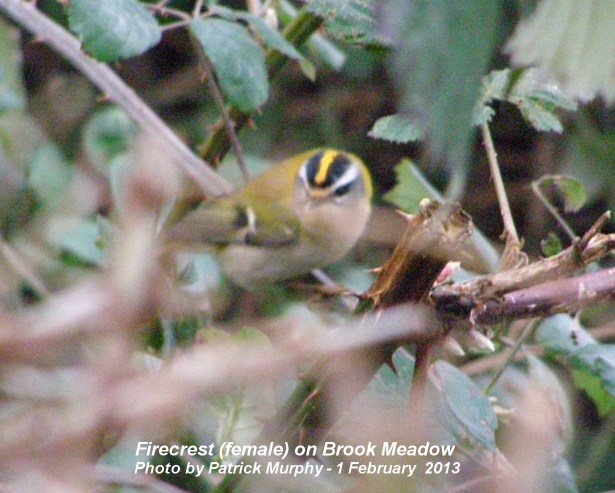
The male with an
orange crest was photographed by Malcolm Phillips in
the usual spot by the observation fence.
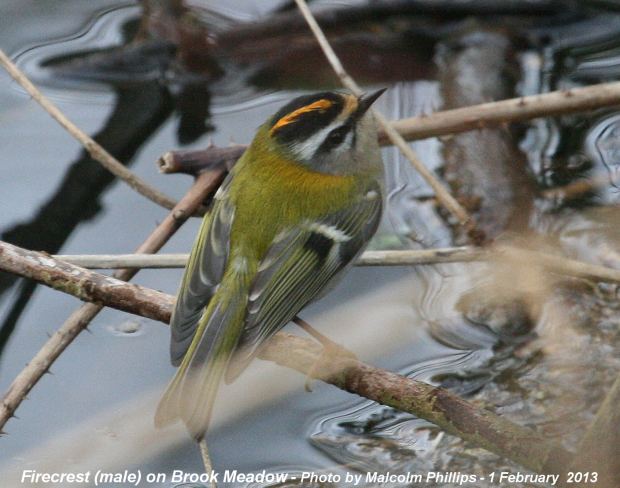
Yet
more Water Voles
There has never been a
start to the year for Water Vole sightings like this
one. Three more reports, one yesterday and two today
(one of two voles) take the total to 23 for 2013 and
we are only just entering February!
1. Yesterday afternoon
at 3.45, Patrick Murphy stopped at the observation
fence in Palmer's Road Copse to look for the
Firecrest, but there was no sign of it. However,
Patrick saw movement on the opposite bank amongst the
reeds and there was a Water Vole. (Section D) He
watched it for about 10 minutes and it popped into the
water a couple of times each time coming out on the
bank by the edge of the water eating and preening
itself. The light was fading, but Patrick managed to
get this reasonable image.
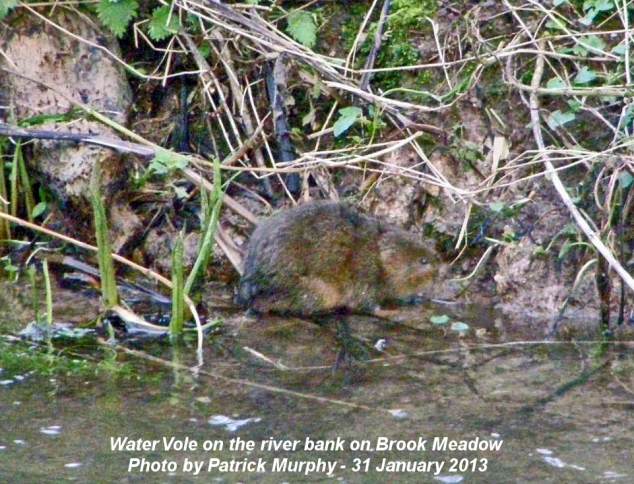
2. Then, this morning
(9.15-9.30), for the second day running, Maurice
Lillie saw two large Water Voles on the west side of
the River Ems, 25-30 metres south of 'S' bend (Section
C). One vole was slightly larger than the other. The
smaller one went into the water, almost totally
submerged for several seconds, appeared to be
struggling, but emerged with some rotten vegetation in
its mouth. It climbed up onto a fallen branch well
above fast flowing water, transferred the 'food' to
its paws, sat up and ate.
3. This afternoon,
Malcolm Phillips watched a Water Vole swim out to the
tree that we saw it at the other day near the Deep
Water sign. Malcolm watched it feeding for about
10mins. It then swam over to the east bank.
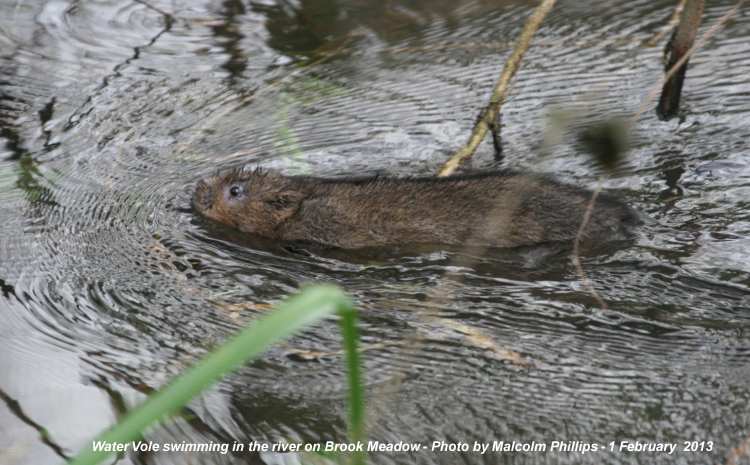
OTHER
NEWS
Garden
first Blackcap
Tony Wootton had a
male Blackcap on his garden feeder this morning. "The
first time in the 13 years that we have lived in
Emsworth that a Blackcap has been seen in our garden.
That's despite Hilary putting out fresh food, towels,
warm water and soap everyday". Pity the BTO Garden
Blackcap survey finished yesterday, but the BTO Garden
BirdWatch survey carries on 52 weeks a year and you
can enter everything. Why not join up?
http://www.bto.org/volunteer-surveys/gbw/join
Here is Tony's
photo. I think he must be offering a spot the Blackcap
prize!
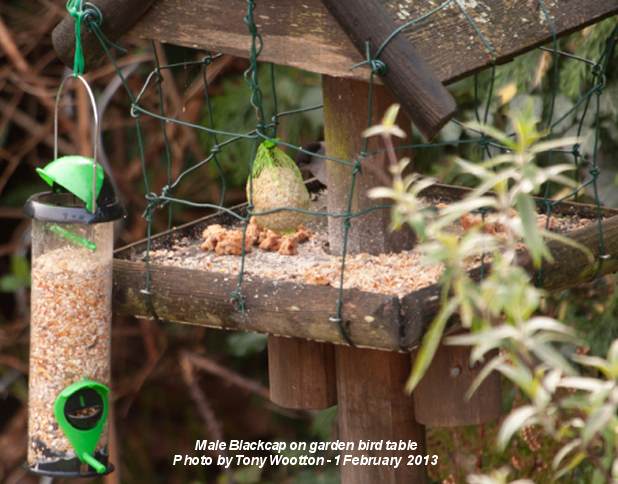
Bumblebee
confirmed
Bryan Pinchen
confirmed the Bumblebee photograph in yesterday's blog
as B. terrestris and, he says, "judging by the pollen
loads and lack of dirty tail it would be a worker of
this species.
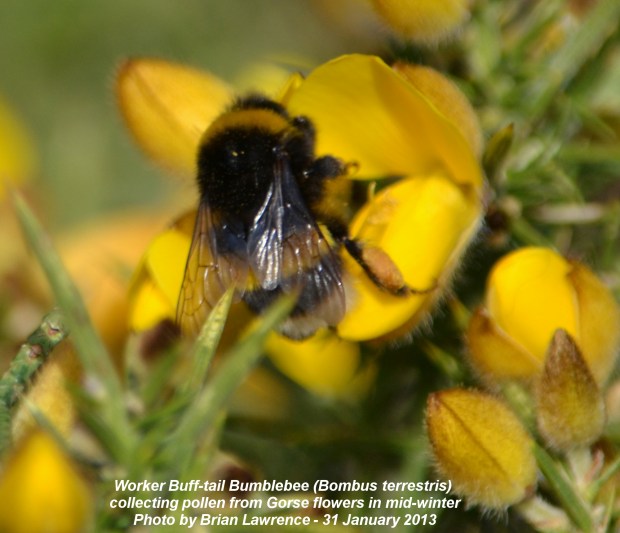
This is most likely as
the very similar B. lucorum rarely starts nests
in the winter. Workers of these two species are
impossible to separate both in the field and under a
microscope. Fingers crossed the nest is successful and
doesn't succumb to the wet - although it has already
survived the recent brief temperature drop and snow".
Hoverflies
Course
There is another
course at Hampshire County Council on Hoverflies led
by Chris Palmer http://www3.hants.gov.uk/events/searcheventslisting/eventsdetail.htm?id=177683
Waxwings
at Fishbourne
Bart Ives reported on
SOS Sightings fifteen or so Waxwings feeding on two
red-berried shrubs just past the sign for Rudkin Place
(off Caspian Close by Salthill Road) Fishbourne this
afternoon. He was absolutely chuffed to see them! That
is the closest they have come in those numbers to
Emsworth.
ANALYSIS
OF OWL PELLETS
Tom Bickerton has been
analysing different owls' pellets to see the different
mammalian prey variation for each owl species. He was
hoping to test his theory that by mid-winter the owl's
diet had changed and roosting birds were now very much
included within the pellet. Here is Tom's account of
the preliminary stage of his investigation:
"I was given some
Tawny pellets in June, so I thought that I could use
these as a control against later pellets.
Unfortunately getting hold of fresh firm later pellets
has proved difficult in such wet conditions, so my
progress has been hindered. Also the owls had not used
the usual roosting trees.
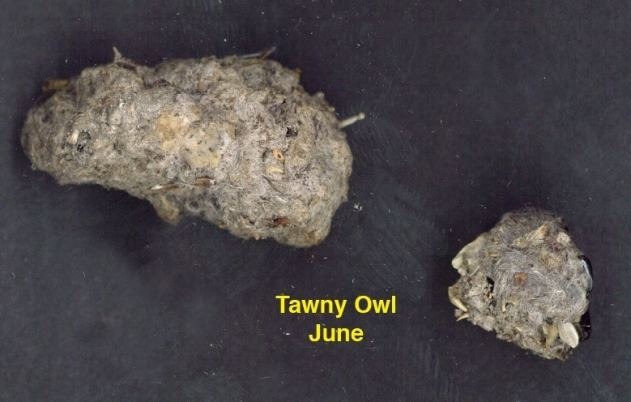
The Long-eared Owl
pellets are standard January issue, but my haste and
stupidity along with their exposure to the frost and
snow caused them to disintegrate with horror in front
of my eyes.
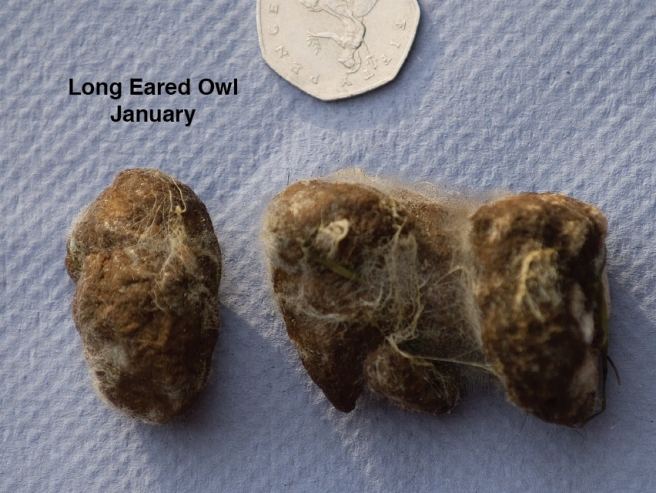
In the control pellets
there are a high percentage of insects mainly Lesser
Stag Beetle, I didn't expect this. The mammals were
Wood Mouse and Field Vole, about 5 to a pellet. I've
shown the lower jawbone; some skulls had survived,
along with most of the skeletons.
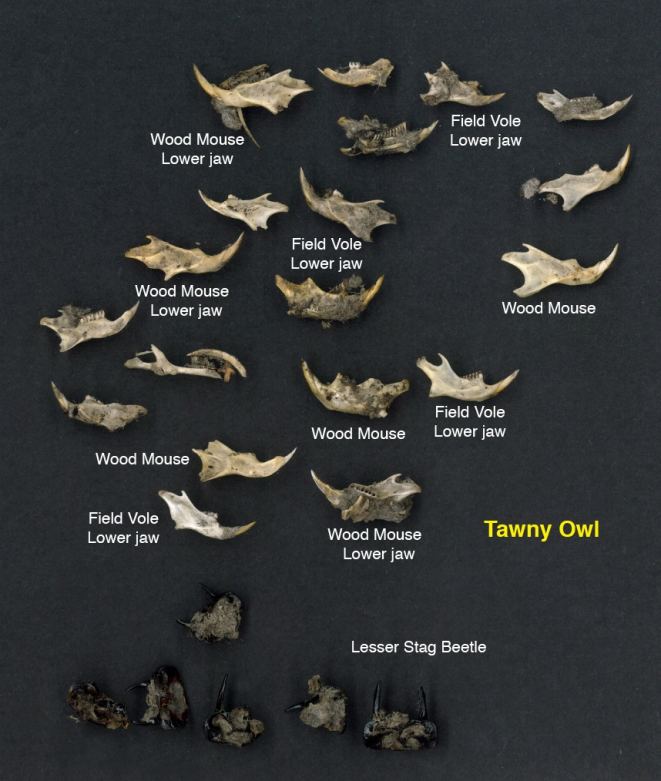
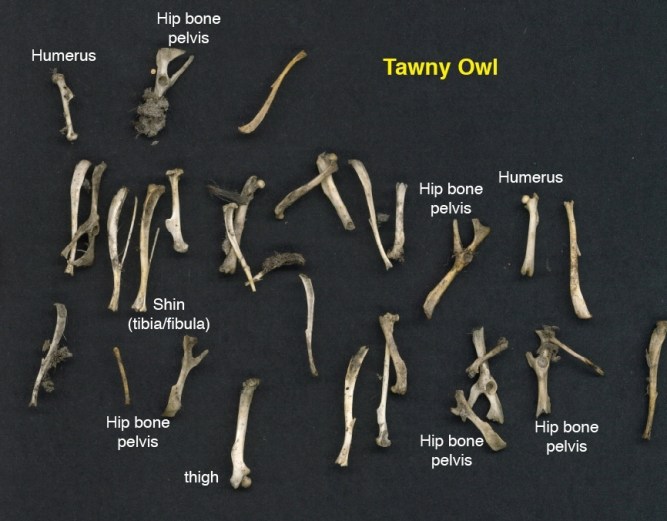
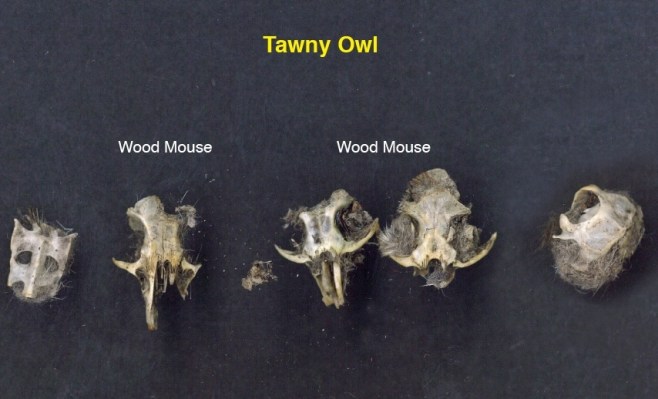
Of interest, emitting
off the pellets was a pungent smell, not unpleasant,
but a very antiseptic fragrance. I'm not a chemist,
but this would explain one reason why the female Tawny
coughs up these pellets in the nest chamber, as they
decayed they must generate heat, therefore sterilizing
the nest, a bit like a compost heap which produces
sterile soil. A theory which if anybody knows for
certain then I would be delighted to be
informed.
I would have like to
have compared Barn/Little owl pellets, with the Tawny;
if anybody does have a fresh supply then I would be
grateful to continue my evaluation. Once the
Short-eared Owls have vacated the golf course I will
endeavour to locate their pellets, and evidence that
bird species taken can be found in their pellets.
On my theory whether
bird species are taken mid-winter, well, I did witness
a Tawny take an unfortunate Fieldfare, which did
surprise me in many ways, not least the prey item
size, but I concluded that the bird was probably in
trouble with the cold and snow.
For
earlier observations go to . . . January
17-31